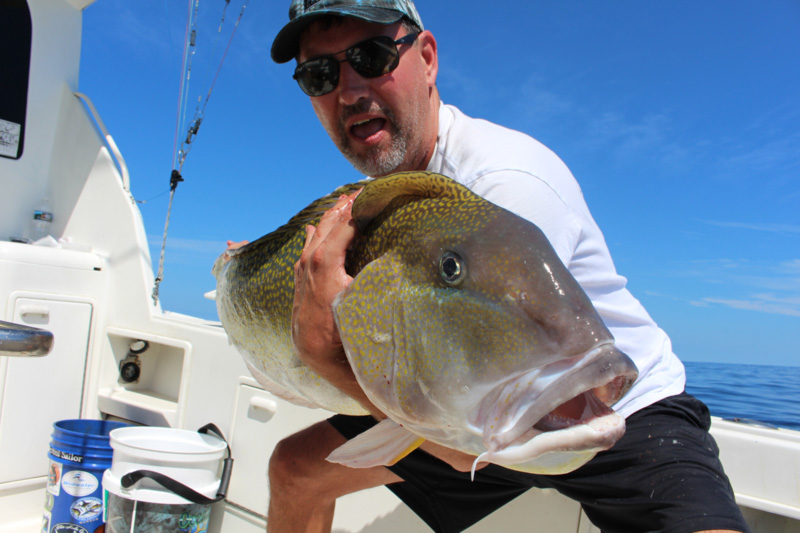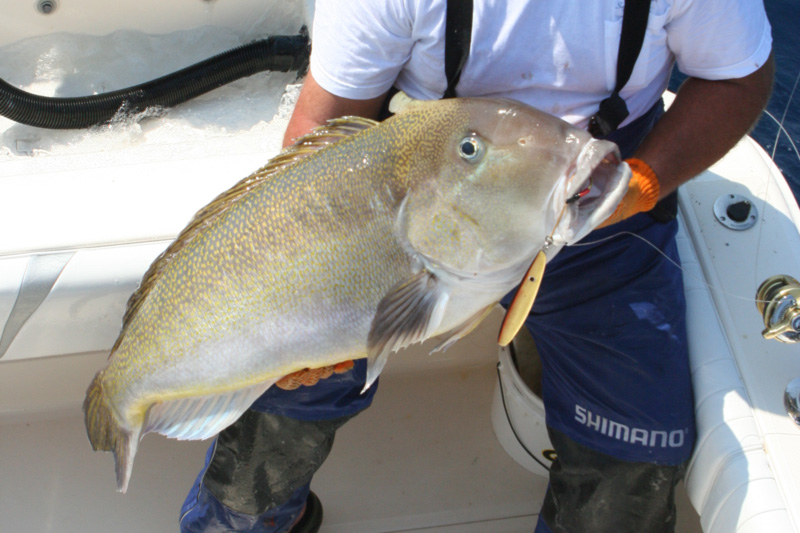Billfish and tunas might get all the glory, but ask a seasoned Mid-Atlantic angler who goes deep drop fishing with any regularity what the best tasting fish in the sea is and you’ll hear golden tilefish brought up again and again. Growing to 50 pounds or more, golden tiles live at the bottom of the ocean in 600 to 800 feet of water where they enjoy frequent meals of Jonah crabs, lobster, and other shellfish. As a result, goldens have a shellfish-like taste. If that isn’t temptation enough, consider this: golden tilefish live in burrows on the bottom and don’t migrate or move around much, so you can get out there and target them at virtually any time of year without wondering if they’ll be around.

Deep Drop Fishing Hotspots
To locate golden tilefish, head for the edge of the Continental Shelf and drag your baits along the bottom in 600 feet down to 800 feet or more. Prime areas will be found when you locate plateaus along the edge of the Shelf where the bottom is composed of mud. (See Prospecting for Golden Tilefish for some tips on how sharpies seek out new locations). There the tilefish dig their burrows, closely clumped together in colonies. As a result, where you find one golden tile you’re likely to find more. The moment you get a fish on the line hit the MOB button on your chartplotter and keep track of your location with each and every bite.
Some good starting points include the canyon bights of both Baltimore and Washington, the westernmost curve of Poor Man’s, and the shelf edge midway between Poor Man’s and Washington. Ready for some numbers? 37’28.870 x 74’22.828 is the kind of spot that holds goldens. But I’d recommend looking at your charts or chartplotter and finding a similar looking area, instead of going to these numbers. I’ve fished this spot for over a decade and it’s more or less tapped out; golden tilefish are slow-growing fish which stick to their burrows and don’t often leave the territory they’ve established. As a result, it’s quite easy to fish out a specific golden spot. Five or six successful trips is usually all you get out of one colony, before the fish’s sizes and numbers begin to rapidly diminish. So constantly prospecting and looking for new territory is a must. As a rule, when you dedicate a day to tilefishing, after putting a few in the cooler the smart move is to cruise for a bit and start trying new spots so you have fresh areas for the future.
How To Catch Golden Tilefish
You have two basic rigging options for golden tilefish: multi-hook deep-drop rigs, and large, heavy jigs. Deep drop rigs, also called “meat-curtains,” should have at least five or six 8/0 to 12/0 circle hooks, and many rigs have a small plastic glow-in-the-dark tube at or near the hook. You’ll sometimes find similar rigs in the tackle shop labeled as “grouper deep-drop rigs,” and these work just fine for tilefish. The hooks can be baited with whole squid, fish chunks, or sea clams. Squid is considered the norm, but some anglers swear by clams. When it comes to fish chunks, stick with oily fish that will stay on the hook like bonito or skipjack. Cutting up leftover ballyhoo or mahi belly will work at times, but are definitely not top offerings. Weights used for meat curtain rigs usually range from three to five pounds — yes, pounds — depending on the speed of your drift. Even with all that lead on the end of your line, it will take between three and six minutes before your bait hits bottom.

When it comes to monster jigs, you’ll want to look for 1.5- to two-pounders. These are stamped 750 to 850 grams, since most of these jigs are made overseas where they haven’t yet abandoned metrics in favor of ‘Merican. (Just wait, I’m sure it’ll happen eventually). Rig them with a single 10/0 to 12/0 hook at the top, and a treble hook that’s only slightly smaller than a grappling anchor at the bottom. A squid gets threaded across the three tines of the treble, and a more rugged bait like a chunk of bonito gets skewered by the top hook. Considering that reeling up takes a solid 10 minutes even without a fish on the line, always make sure that at least one of the baits is tough and unlikely to get stripped off by small nibblers.
Regardless of which type of rig you use, it’s absolutely essential to use braid mainline. Monofilament will stretch so much you will hardly be able to tell when the rig hits bottom, much less if a fish is hooked. Early in my tilefish experimentation days I started with mono and reeled in a 12-pounder that I had no idea was even on the line. With braid, however, you’ll feel the nibbles 800 feet below the boat. Rod choice is a matter of personal preference, but high-speed offshore reels are ideal for the task. Try cranking with a low gear ratio and you’ll discover it takes twice as long to bring a rig up from the bottom. Of course, you can also get an electric reel or slap a “Reel Cranky” attachment onto your power drill and use it to retrieve your line — in depths like these, no one will blame you.
For more detailed info on jigging for tilefish in specific, see Jigging for Golden Tilefish.
Once your bait reaches bottom you need to make sure it stays down there. Be prepared to slack out additional line as you drift, if necessary. As you might guess, this means you’ll be hoping for low wind and current and in some conditions, you may need to use the boat’s powerplants to slow your drift.
Those using the meat-curtain will simply dredge bottom with it, and since these rigs have circle hooks, rather than performing a hook-set simply wait for the rod to bend over and then begin cranking. When a small fish gets on the line (rose fish in the one- to two-pound range are often down there, too) savvy tilefishers will simply ignore them and wait for a larger fish to grab one of the other baits.

Jiggers will want to hover their jig just over the bottom, allowing the boat to impart all necessary action. Sweeping the rod is counter-productive on all but the calmest days, as these fish usually like to strike when the slow roll of the boat causes the jig to move at a reasonable rate of speed. Make sure you feel the jig touch down every few times the boat rocks to be sure it’s just over the bottom, and when you feel a strike swing for the stars.
Remember people, you are what you eat. And in this case, those big golden tiles taste like the crustaceans they’ve been feeding on — if I were voting on the best-tasting fish in the Mid-Atlantic region, they’d be a winner.
Golden Tilefish Recipe
Here's offshore sharpie John Unkart’s exceptionally complex golden tilecake/crabcake recipe:
- Fillet your golden tilefish, cut the fillets into chunks, and steam the meat.
- Break up the meat into flakes, season it exactly as you would when making a crab cake, and form the tilefish into cakes.
- Deep fry or broil, exactly as you would a crab cake.
Once ready, serve the tile-cakes to your friends and family but tell them they are crab cakes. After they tell you how awesome your crab cakes are, let them in on the secret — you will be able to fool them!
Tilefish Fishing Tips
- If you reel a fish halfway up and the hook pulls free, don’t leave the area. Instead, stick around for a few minutes and scan the surface. Quite often the fish’s air bladder inflates on the way up, it’s unable to swim back down to the bottom, and it floats up to the surface. When you spot what looks like a basketball bobbing around, idle over and retrieve it.
- When your tilefish baits are being eaten by sharks over and over during the cold months of the year (when massive numbers of spiny dogfish gather along the edge of the Continental Shelf) move deeper. Sometimes getting 50 or 100 feet deeper puts you beyond the sharks, but still in tilefish territory.
- If you’re in a spot where you know there are tilefish but don’t get bit, keep plugging away or return an hour or two later. Like many species, sometimes golden tiles simply don’t bite and then for whatever reason, they suddenly turn on.
- Never jig a meat-curtain rig, just let it drag. Jigging is a great way to pull the circle hooks right out of the mouths of the fish that are trying to eat your baits.
- As you drop, if a line stops falling short of the bottom start reeling like mad. Sometimes mahi-mahi or tuna grab a bait as it’s headed for the bottom and the only way you’ll know is if your rig suddenly seems to levitate at mid-depth.
- If a rig set on bottom heads for the surface without any input from you, again, start reeling like mad. When tuna grab a bait (yes, it does happen) they usually swim towards the surface.
For information on targeting blueline tilefish rather than goldens, which live shallower and are often found mixed with black sea bass, check out Bass N Blue: Sea Bass and Blueline Tilefish.